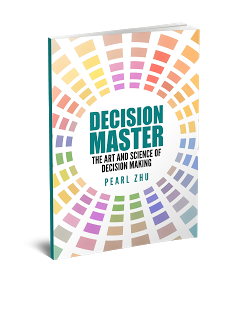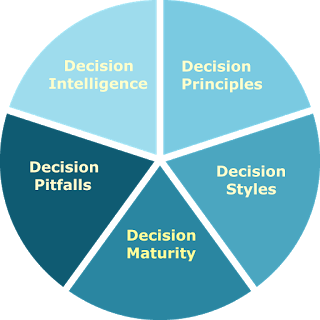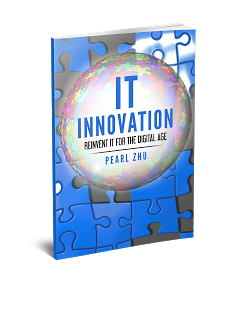Pearl Zhu's Blog, page 1257
January 25, 2017
The New Book “Decision Master-The Art and Science of Decision Making” Introduction
Decision making is an art only until the person understands the science.
 Both businesses and the world become over-complex, hyper-connected, extremely uncertain and ambiguous than ever, making effective decisions is both art and science. There are blind spots block the vision and there are pitfalls on the way. Decision Masters refer to the digital leaders or professionals who can leverage multidimensional thought processes, information and intuition, take a step-wise scenario for making effective decisions consistently. Decision Masters also refer to the businesses or organizations that follow a set of well-defined principles, leverage fine-tuned decision processes, efficient information management system, decision frameworks, tools, and metrics to enable people across the organization making effective decisions collaboratively. Decision-making is both art and science. More specifically, what are the digital philosophy, principles, and practices to improve decision-making effectiveness and increase the overall business responsiveness and maturity?
Both businesses and the world become over-complex, hyper-connected, extremely uncertain and ambiguous than ever, making effective decisions is both art and science. There are blind spots block the vision and there are pitfalls on the way. Decision Masters refer to the digital leaders or professionals who can leverage multidimensional thought processes, information and intuition, take a step-wise scenario for making effective decisions consistently. Decision Masters also refer to the businesses or organizations that follow a set of well-defined principles, leverage fine-tuned decision processes, efficient information management system, decision frameworks, tools, and metrics to enable people across the organization making effective decisions collaboratively. Decision-making is both art and science. More specifically, what are the digital philosophy, principles, and practices to improve decision-making effectiveness and increase the overall business responsiveness and maturity?
“Decision Master” is the guidebook to perceive digital mindsets with multidimensional decision intelligence, define a set of decision-making principles, articulate potential pitfalls in decision-making scenario, describe digital decision-making styles, summarize the important elements in building the decision-making capability and taking stepwise steps to achieve decision maturity.
 Chapter 1 Decision Intelligence: Intelligence has been defined in several ways. First, intelligence is a cognitive process involving rational and abstract thinking. Second, it is goal-directed and purposeful, and it means that all intelligent activities such as decision-making, are planned to reach a self-determined goal. Finally, it involves social competence to help individuals adjust to their environmental surroundings. It is important to make sound decisions via leveraging multidimensional intelligence.
Chapter 1 Decision Intelligence: Intelligence has been defined in several ways. First, intelligence is a cognitive process involving rational and abstract thinking. Second, it is goal-directed and purposeful, and it means that all intelligent activities such as decision-making, are planned to reach a self-determined goal. Finally, it involves social competence to help individuals adjust to their environmental surroundings. It is important to make sound decisions via leveraging multidimensional intelligence.
Chapter 2 Decision-Making Principles: One significant effect of digitization is increased velocity, complexity, ambiguity, unpredictability, and a need for a faster response to changes in businesses and industries based on effective and efficient decision making. It’s important to set well-defined principles for guiding decision-making on a day to day basis. The principles as a digital compass will guide all levels of the organization to be able to make decisions in a very organic relationship with its environment.
Chapter 3 Digital Decision-Making Styles: Decision making is both the art and science. Having all the facts to make the best decision is a utopia we would all like. But in practice, each person has his or her own cognitive strength, knowledge expertise, capability, experience, or the tailored style to become a decision master. At group setting, in order to make the best decisions, it is better having a mix of complementing mindsets, skills and decision-making styles for achieving decision maturity.
Chapter 4 Decision-Making Pitfalls: Making decision is one of the significant tasks for digital leaders and professionals today. However, the high ratio of strategic decisions has been made poorly and causes catastrophic effects. What are key factors contributing to poor quality decision-making? How to avoid potential decision-making pitfalls for improving decisions effectiveness and maturity.
Chapter 5 Decision Maturity: The reason decision making is often a difficult task because it is contextual and situational, it takes a unique individual to understand a situation and relate it to the present. There are many variables in complex decision making, there are tradeoffs you have to leverage, and there is no magic formula to follow. At the Digital Era, making wise decisions means to leverage multidimensional thought processes, advanced analytic tools, the human intuition, and efficient processes to improve the overall effectiveness and maturity of decision making.
Decision making is an art only until the person understands the science (process, analytics, tool, etc.). It takes the multidisciplinary approach, to frame the right questions before answering them. It has to leverage multidimensional decision intelligence with a combination of both creative thinking and critical thinking, divergent thinking and convergent thinking, strategic thinking and systems thinking, holistic thinking and paradoxical thinking. Ensure you are both information savvy and be flexible to select the optimal solutions with decision wisdom.
Decision Master Book Summary
Decision Master Amazon Order Link
Decision Master B&N Order Link
Decision Master IBook Ordre Link
Follow us at: @Pearl_Zhu
 Both businesses and the world become over-complex, hyper-connected, extremely uncertain and ambiguous than ever, making effective decisions is both art and science. There are blind spots block the vision and there are pitfalls on the way. Decision Masters refer to the digital leaders or professionals who can leverage multidimensional thought processes, information and intuition, take a step-wise scenario for making effective decisions consistently. Decision Masters also refer to the businesses or organizations that follow a set of well-defined principles, leverage fine-tuned decision processes, efficient information management system, decision frameworks, tools, and metrics to enable people across the organization making effective decisions collaboratively. Decision-making is both art and science. More specifically, what are the digital philosophy, principles, and practices to improve decision-making effectiveness and increase the overall business responsiveness and maturity?
Both businesses and the world become over-complex, hyper-connected, extremely uncertain and ambiguous than ever, making effective decisions is both art and science. There are blind spots block the vision and there are pitfalls on the way. Decision Masters refer to the digital leaders or professionals who can leverage multidimensional thought processes, information and intuition, take a step-wise scenario for making effective decisions consistently. Decision Masters also refer to the businesses or organizations that follow a set of well-defined principles, leverage fine-tuned decision processes, efficient information management system, decision frameworks, tools, and metrics to enable people across the organization making effective decisions collaboratively. Decision-making is both art and science. More specifically, what are the digital philosophy, principles, and practices to improve decision-making effectiveness and increase the overall business responsiveness and maturity?
“Decision Master” is the guidebook to perceive digital mindsets with multidimensional decision intelligence, define a set of decision-making principles, articulate potential pitfalls in decision-making scenario, describe digital decision-making styles, summarize the important elements in building the decision-making capability and taking stepwise steps to achieve decision maturity.
 Chapter 1 Decision Intelligence: Intelligence has been defined in several ways. First, intelligence is a cognitive process involving rational and abstract thinking. Second, it is goal-directed and purposeful, and it means that all intelligent activities such as decision-making, are planned to reach a self-determined goal. Finally, it involves social competence to help individuals adjust to their environmental surroundings. It is important to make sound decisions via leveraging multidimensional intelligence.
Chapter 1 Decision Intelligence: Intelligence has been defined in several ways. First, intelligence is a cognitive process involving rational and abstract thinking. Second, it is goal-directed and purposeful, and it means that all intelligent activities such as decision-making, are planned to reach a self-determined goal. Finally, it involves social competence to help individuals adjust to their environmental surroundings. It is important to make sound decisions via leveraging multidimensional intelligence.
Chapter 2 Decision-Making Principles: One significant effect of digitization is increased velocity, complexity, ambiguity, unpredictability, and a need for a faster response to changes in businesses and industries based on effective and efficient decision making. It’s important to set well-defined principles for guiding decision-making on a day to day basis. The principles as a digital compass will guide all levels of the organization to be able to make decisions in a very organic relationship with its environment.
Chapter 3 Digital Decision-Making Styles: Decision making is both the art and science. Having all the facts to make the best decision is a utopia we would all like. But in practice, each person has his or her own cognitive strength, knowledge expertise, capability, experience, or the tailored style to become a decision master. At group setting, in order to make the best decisions, it is better having a mix of complementing mindsets, skills and decision-making styles for achieving decision maturity.
Chapter 4 Decision-Making Pitfalls: Making decision is one of the significant tasks for digital leaders and professionals today. However, the high ratio of strategic decisions has been made poorly and causes catastrophic effects. What are key factors contributing to poor quality decision-making? How to avoid potential decision-making pitfalls for improving decisions effectiveness and maturity.
Chapter 5 Decision Maturity: The reason decision making is often a difficult task because it is contextual and situational, it takes a unique individual to understand a situation and relate it to the present. There are many variables in complex decision making, there are tradeoffs you have to leverage, and there is no magic formula to follow. At the Digital Era, making wise decisions means to leverage multidimensional thought processes, advanced analytic tools, the human intuition, and efficient processes to improve the overall effectiveness and maturity of decision making.
Decision making is an art only until the person understands the science (process, analytics, tool, etc.). It takes the multidisciplinary approach, to frame the right questions before answering them. It has to leverage multidimensional decision intelligence with a combination of both creative thinking and critical thinking, divergent thinking and convergent thinking, strategic thinking and systems thinking, holistic thinking and paradoxical thinking. Ensure you are both information savvy and be flexible to select the optimal solutions with decision wisdom.
Decision Master Book Summary
Decision Master Amazon Order Link
Decision Master B&N Order Link
Decision Master IBook Ordre Link
Follow us at: @Pearl_Zhu
Published on January 25, 2017 21:58
The New Book “Decision Master-The Art and Science of Decison Making” Introduction
Decision making is an art only until the person understands the science.
 Both businesses and the world become over-complex, hyper-connected, extremely uncertain and ambiguous than ever, making effective decisions is both art and science. There are blind spots block the vision and there are pitfalls on the way. Decision Masters refer to the digital leaders or professionals who can leverage multidimensional thought processes, information and intuition, take a step-wise scenario for making effective decisions consistently. Decision Masters also refer to the businesses or organizations that follow a set of well-defined principles, leverage fine-tuned decision processes, efficient information management system, decision frameworks, tools, and metrics to enable people across the organization making effective decisions collaboratively. Decision-making is both art and science. More specifically, what are the digital philosophy, principles, and practices to improve decision-making effectiveness and increase the overall business responsiveness and maturity?
Both businesses and the world become over-complex, hyper-connected, extremely uncertain and ambiguous than ever, making effective decisions is both art and science. There are blind spots block the vision and there are pitfalls on the way. Decision Masters refer to the digital leaders or professionals who can leverage multidimensional thought processes, information and intuition, take a step-wise scenario for making effective decisions consistently. Decision Masters also refer to the businesses or organizations that follow a set of well-defined principles, leverage fine-tuned decision processes, efficient information management system, decision frameworks, tools, and metrics to enable people across the organization making effective decisions collaboratively. Decision-making is both art and science. More specifically, what are the digital philosophy, principles, and practices to improve decision-making effectiveness and increase the overall business responsiveness and maturity?
“Decision Master” is the guidebook to perceive digital mindsets with multidimensional decision intelligence, define a set of decision-making principles, articulate potential pitfalls in decision-making scenario, describe digital decision-making styles, summarize the important elements in building the decision-making capability and taking stepwise steps to achieve decision maturity.
 Chapter 1 Decision Intelligence: Intelligence has been defined in several ways. First, intelligence is a cognitive process involving rational and abstract thinking. Second, it is goal-directed and purposeful, and it means that all intelligent activities such as decision-making, are planned to reach a self-determined goal. Finally, it involves social competence to help individuals adjust to their environmental surroundings. It is important to make sound decisions via leveraging multidimensional intelligence.
Chapter 1 Decision Intelligence: Intelligence has been defined in several ways. First, intelligence is a cognitive process involving rational and abstract thinking. Second, it is goal-directed and purposeful, and it means that all intelligent activities such as decision-making, are planned to reach a self-determined goal. Finally, it involves social competence to help individuals adjust to their environmental surroundings. It is important to make sound decisions via leveraging multidimensional intelligence.
Chapter 2 Decision-Making Principles: One significant effect of digitization is increased velocity, complexity, ambiguity, unpredictability, and a need for a faster response to changes in businesses and industries based on effective and efficient decision making. It’s important to set well-defined principles for guiding decision-making on a day to day basis. The principles as a digital compass will guide all levels of the organization to be able to make decisions in a very organic relationship with its environment.
Chapter 3 Digital Decision-Making Styles: Decision making is both the art and science. Having all the facts to make the best decision is a utopia we would all like. But in practice, each person has his or her own cognitive strength, knowledge expertise, capability, experience, or the tailored style to become a decision master. At group setting, in order to make the best decisions, it is better having a mix of complementing mindsets, skills and decision-making styles for achieving decision maturity.
Chapter 4 Decision-Making Pitfalls: Making decision is one of the significant tasks for digital leaders and professionals today. However, the high ratio of strategic decisions has been made poorly and causes catastrophic effects. What are key factors contributing to poor quality decision-making? How to avoid potential decision-making pitfalls for improving decisions effectiveness and maturity.
Chapter 5 Decision Maturity: The reason decision making is often a difficult task because it is contextual and situational, it takes a unique individual to understand a situation and relate it to the present. There are many variables in complex decision making, there are tradeoffs you have to leverage, and there is no magic formula to follow. At the Digital Era, making wise decisions means to leverage multidimensional thought processes, advanced analytic tools, the human intuition, and efficient processes to improve the overall effectiveness and maturity of decision making.
Decision making is an art only until the person understands the science (process, analytics, tool, etc.). It takes the multidisciplinary approach, to frame the right questions before answering them. It has to leverage multidimensional decision intelligence with a combination of both creative thinking and critical thinking, divergent thinking and convergent thinking, strategic thinking and systems thinking, holistic thinking and paradoxical thinking. Ensure you are both information savvy and be flexible to select the optimal solutions with decision wisdom.
Follow us at: @Pearl_Zhu
 Both businesses and the world become over-complex, hyper-connected, extremely uncertain and ambiguous than ever, making effective decisions is both art and science. There are blind spots block the vision and there are pitfalls on the way. Decision Masters refer to the digital leaders or professionals who can leverage multidimensional thought processes, information and intuition, take a step-wise scenario for making effective decisions consistently. Decision Masters also refer to the businesses or organizations that follow a set of well-defined principles, leverage fine-tuned decision processes, efficient information management system, decision frameworks, tools, and metrics to enable people across the organization making effective decisions collaboratively. Decision-making is both art and science. More specifically, what are the digital philosophy, principles, and practices to improve decision-making effectiveness and increase the overall business responsiveness and maturity?
Both businesses and the world become over-complex, hyper-connected, extremely uncertain and ambiguous than ever, making effective decisions is both art and science. There are blind spots block the vision and there are pitfalls on the way. Decision Masters refer to the digital leaders or professionals who can leverage multidimensional thought processes, information and intuition, take a step-wise scenario for making effective decisions consistently. Decision Masters also refer to the businesses or organizations that follow a set of well-defined principles, leverage fine-tuned decision processes, efficient information management system, decision frameworks, tools, and metrics to enable people across the organization making effective decisions collaboratively. Decision-making is both art and science. More specifically, what are the digital philosophy, principles, and practices to improve decision-making effectiveness and increase the overall business responsiveness and maturity?
“Decision Master” is the guidebook to perceive digital mindsets with multidimensional decision intelligence, define a set of decision-making principles, articulate potential pitfalls in decision-making scenario, describe digital decision-making styles, summarize the important elements in building the decision-making capability and taking stepwise steps to achieve decision maturity.
 Chapter 1 Decision Intelligence: Intelligence has been defined in several ways. First, intelligence is a cognitive process involving rational and abstract thinking. Second, it is goal-directed and purposeful, and it means that all intelligent activities such as decision-making, are planned to reach a self-determined goal. Finally, it involves social competence to help individuals adjust to their environmental surroundings. It is important to make sound decisions via leveraging multidimensional intelligence.
Chapter 1 Decision Intelligence: Intelligence has been defined in several ways. First, intelligence is a cognitive process involving rational and abstract thinking. Second, it is goal-directed and purposeful, and it means that all intelligent activities such as decision-making, are planned to reach a self-determined goal. Finally, it involves social competence to help individuals adjust to their environmental surroundings. It is important to make sound decisions via leveraging multidimensional intelligence.
Chapter 2 Decision-Making Principles: One significant effect of digitization is increased velocity, complexity, ambiguity, unpredictability, and a need for a faster response to changes in businesses and industries based on effective and efficient decision making. It’s important to set well-defined principles for guiding decision-making on a day to day basis. The principles as a digital compass will guide all levels of the organization to be able to make decisions in a very organic relationship with its environment.
Chapter 3 Digital Decision-Making Styles: Decision making is both the art and science. Having all the facts to make the best decision is a utopia we would all like. But in practice, each person has his or her own cognitive strength, knowledge expertise, capability, experience, or the tailored style to become a decision master. At group setting, in order to make the best decisions, it is better having a mix of complementing mindsets, skills and decision-making styles for achieving decision maturity.
Chapter 4 Decision-Making Pitfalls: Making decision is one of the significant tasks for digital leaders and professionals today. However, the high ratio of strategic decisions has been made poorly and causes catastrophic effects. What are key factors contributing to poor quality decision-making? How to avoid potential decision-making pitfalls for improving decisions effectiveness and maturity.
Chapter 5 Decision Maturity: The reason decision making is often a difficult task because it is contextual and situational, it takes a unique individual to understand a situation and relate it to the present. There are many variables in complex decision making, there are tradeoffs you have to leverage, and there is no magic formula to follow. At the Digital Era, making wise decisions means to leverage multidimensional thought processes, advanced analytic tools, the human intuition, and efficient processes to improve the overall effectiveness and maturity of decision making.
Decision making is an art only until the person understands the science (process, analytics, tool, etc.). It takes the multidisciplinary approach, to frame the right questions before answering them. It has to leverage multidimensional decision intelligence with a combination of both creative thinking and critical thinking, divergent thinking and convergent thinking, strategic thinking and systems thinking, holistic thinking and paradoxical thinking. Ensure you are both information savvy and be flexible to select the optimal solutions with decision wisdom.
Follow us at: @Pearl_Zhu
Published on January 25, 2017 21:58
What are the Causes to IT Ineffectiveness
 IT is the spinal cord for the organization, integrating various functional capabilities to bring out technology-enabled business solutions, motivating the IT team to constantly deliver products/services for improving high-performing results and delight both internal and external customers. However, most IT organizations today are still perceived as a cost center and get stuck at the lower level of maturity. What are the causes to IT ineffectiveness and how to keep IT “digital fit,” and make IT the true business partner and growth engine?
IT is the spinal cord for the organization, integrating various functional capabilities to bring out technology-enabled business solutions, motivating the IT team to constantly deliver products/services for improving high-performing results and delight both internal and external customers. However, most IT organizations today are still perceived as a cost center and get stuck at the lower level of maturity. What are the causes to IT ineffectiveness and how to keep IT “digital fit,” and make IT the true business partner and growth engine?
IT ineffectiveness is caused by running IT via inside-out operation lenses only: The effective management of IT is not just within IT, to put another way, IT management is not just the business of IT department, it’s the responsibility of the entire business. The management of IT goes beyond IT because often information has to flow across functionally with the business ecosystem in order to capture the real business insight in a comprehensive way. IT is not just an isolated support function or act as a controller only. Effective IT management means understanding every island of operation and every workflow process smoothly. Especially in the digital organizations empowered by digital technologies today, the traditional boundaries of business functions are disappearing or becoming very murky, it takes organizational scope support to enable data flow and manage business information life cycle smoothly. Hence, IT management effectiveness is not based on the inside-out IT operational lens, but through the outside-in business lens. CIOs need to act as the business leader first, and the technology manager second, they have to gain the comprehensive business understanding so that they would be able to identify true cost savings, workflow optimizations, and additional revenue opportunities for the entire company and improve its effectiveness and business competency. The proactive IT leaders and sponsors attend business reviews with the various business stakeholders in attendance and equally invited those business stakeholders to their IT forums, to share IT innovation, strengths, weaknesses, opportunities and threats present within IT, they listen to the business for gaining in-depth understanding of the issues, put in action plans to run a high-effective business.
Silo thinking, overly rigid processes and the gaps between IT and business cause IT ineffectiveness: With increasing pace of changes, the process of changing a good business idea into an effective IT solution has become awfully complex and messy in many larger organizations. There is a combination of factors at work which indeed link closely to the issues around business-IT enablement. Too often IT is involved too late in the decision-making process, that causes communication gap and the gap between strategic goals and implementation. That also tarnish IT reputation as the change laggard which cannot deliver what the business needs on time. Unless there are the collaborative and understanding environments, the perception is that IT is raising roadblocks. Hence, IT leadership needs to have the seat at the big table, sort through the issues, develop rationalizations and achieve mutually acceptable solutions that are then communicated up, down and across the enterprise. Digital strategy executions are not linear steps, but a dynamic continuum. IT also has to optimize business processes to improve effectiveness, you can not deliver value without "de-complexitizing" and make transparent what is being delivered and how or what is being delivered. As part of and in concert with the top management team, IT simplifying business processes following agile principles and common sense helps a great deal in improving predictability, which makes it easier to manage expectations, and improving its manageability and effectiveness.
 IT ineffectiveness is also caused by the “controller’s mentality” with “fixing symptom” practices: The reason most of IT organizations get stuck in the lower level of maturity is because they are busy on fixing the symptoms, or taking care of immediate problems, with ignorance of digging into the root cause of problems, or putting too little resources on strategic initiatives. Many IT organizations act as the “controller role,” not a business enabler or change driver. The worst thing to do is just putting the policy in place to mandate it comes through IT since business will perceive IT as not a real business partner. What should be focused on is the integration of IT into the business decisions and processes. So, IT can proactively work as an integral part of the business to capitalize on opportunity via an in-depth understanding of the business and leading the digital transformation smoothly. To improve management effectiveness, IT has to dig through the root cause of old or emergent business issues and deliver the best solution to the business problems which meet business’s requirement for the long run and tailor customer’s needs, not just from an IT perspective, but from the business's viewpoint.
IT ineffectiveness is also caused by the “controller’s mentality” with “fixing symptom” practices: The reason most of IT organizations get stuck in the lower level of maturity is because they are busy on fixing the symptoms, or taking care of immediate problems, with ignorance of digging into the root cause of problems, or putting too little resources on strategic initiatives. Many IT organizations act as the “controller role,” not a business enabler or change driver. The worst thing to do is just putting the policy in place to mandate it comes through IT since business will perceive IT as not a real business partner. What should be focused on is the integration of IT into the business decisions and processes. So, IT can proactively work as an integral part of the business to capitalize on opportunity via an in-depth understanding of the business and leading the digital transformation smoothly. To improve management effectiveness, IT has to dig through the root cause of old or emergent business issues and deliver the best solution to the business problems which meet business’s requirement for the long run and tailor customer’s needs, not just from an IT perspective, but from the business's viewpoint.
In fact, IT faces many management dilemmas, it’s often overloaded and understaffed, it has to become more innovative but also handle potential risks effectively; it needs to strike the right balance of maintaining a healthy “run, grow and transform” portfolio. TO improve effectiveness, CIOs need to have information technology insight and foresight upon potential opportunities to retool business, re-imagine growth possibilities, set the right priority, and manage IT and business resource efficiently.
Follow us at: @Pearl_Zhu
Published on January 25, 2017 21:55
January 24, 2017
The Monthly “IT Innovation” Book Tuning Jan. 2017
 IT plays a significant role in managing information-knowledge-insight cycle and fostering innovation by leveraging disruptive technologies and enriched information flow. But more specifically, how can IT build differentiated capabilities to become an information power center and an innovation hub? The purpose of the book “IT innovation - Reinvent IT for the Digital Age” is to help business and IT leaders and digital professionals ride above the learning curve, reinvent IT as an innovation hub and game changer; reimagine IT as an innovation outlier; renovate a hybrid IT and digital organization; fine-tune IT as the digital whole brain of the organization; accelerate IT on the fast lane, rebuild IT as the business capability multiplier; empower IT as a digital change agent; and leverage the “alphabetic elements” to run a highly innovative IT organization for the digital age.
IT plays a significant role in managing information-knowledge-insight cycle and fostering innovation by leveraging disruptive technologies and enriched information flow. But more specifically, how can IT build differentiated capabilities to become an information power center and an innovation hub? The purpose of the book “IT innovation - Reinvent IT for the Digital Age” is to help business and IT leaders and digital professionals ride above the learning curve, reinvent IT as an innovation hub and game changer; reimagine IT as an innovation outlier; renovate a hybrid IT and digital organization; fine-tune IT as the digital whole brain of the organization; accelerate IT on the fast lane, rebuild IT as the business capability multiplier; empower IT as a digital change agent; and leverage the “alphabetic elements” to run a highly innovative IT organization for the digital age.
“IT Innovation” Monthly Book Tuning
 The New Book “IT Innovation - Reinvent IT for the Digital Age: Nowadays we are living in an information abundant world where technology is pervasive and the masses are looking for their own experiences to introduce new technology into the business. There are both incremental innovation and radical innovation. IT is often the driving force for both. IT plays a significant role in managing information-knowledge-insight cycle and fostering innovation by leveraging disruptive technologies and enriched information flow. But more specifically, how can IT build differentiated capabilities to become an information power center and an innovation hub
The New Book “IT Innovation - Reinvent IT for the Digital Age: Nowadays we are living in an information abundant world where technology is pervasive and the masses are looking for their own experiences to introduce new technology into the business. There are both incremental innovation and radical innovation. IT is often the driving force for both. IT plays a significant role in managing information-knowledge-insight cycle and fostering innovation by leveraging disruptive technologies and enriched information flow. But more specifically, how can IT build differentiated capabilities to become an information power center and an innovation hub
The Multi-Color of Digital IT? IT is in the middle of a sea change, traditional IT organization is monolithic, monocolored, stereotypical, and slow to change. In order to improve the tarnished image of IT, digital CIOs must set principles and guidelines, but not overly restrictive rules to run digital IT with the enriched color of IT leadership, empowered IT talent teams and enhanced IT-business partnership to make a leap in digital transformation.
How to Run a High-Mature IT Organization in a Proactive Mode Technology is pervasive, business initiatives and digital transformation today nearly always involve some form of technology implementation or information analysis; IT touches both hard business processes and soft human behavior. However, the majority of IT organizations still run in the reactive mode, take the order, fix the symptoms, and keep the lights on, get stuck at the lower level of maturity. With emergent digital trend and the increasing speed of changes, innovation is no longer “nice to have,” but must have the capability to make the organization thrive. IT has the necessary structure/ methodology/tool in shaping the new box of thinking and managing the emergent digital complexity with the characteristics such as hyper-connectivity, hyper-diversity, and hyper-dynamism. And it is strategic imperative to run a high mature IT in a proactive mode to catalyze changes and orchestrate innovation.
A set of Q&As (V) Dealing with IT Innovation Dilemma” Modern CIOs face many challenges, it is not sufficient to only keep the lights on. Regardless of which industry or the nature of organization you are in, being a digital leader will need to master the art of creating unique, differentiating value from piles of commoditized technologies and take advantage of the emergent digital trend as well; digital CIOs also have multiple personas, “Chief Innovation Officer,” “Chief Insight Officer,” “Chief Improvement Officer,” “Chief Information Officer,” and here, we discuss CIOs as “Chief Inquisitive Officer,” with a set of Q&As to lead digital transformation.
 Running IT as the “Light Power” to Navigate Digital Transformation IT is shifting its reputation from a reactive help desk and support center behind the scene to a proactive innovation engine and change agent leading at front. A CIO must be able to add value to an organization through strategic thinking involves being visionary. Traditional IT in the industrial age is often blamed as the controller to slow down the speed of change. Digital IT is running at much faster speed, and being elevated to the “light power” for navigating digital transformation via identify obstacles and reaching the destination more confidently.
Running IT as the “Light Power” to Navigate Digital Transformation IT is shifting its reputation from a reactive help desk and support center behind the scene to a proactive innovation engine and change agent leading at front. A CIO must be able to add value to an organization through strategic thinking involves being visionary. Traditional IT in the industrial age is often blamed as the controller to slow down the speed of change. Digital IT is running at much faster speed, and being elevated to the “light power” for navigating digital transformation via identify obstacles and reaching the destination more confidently.
The “Future of CIO” Blog has reached 1.7 million page views with about 3300+ blog posting in 59+ different categories of leadership, management, strategy, digitalization, change/talent, etc. The content richness is not for its own sake, but to convey the vision and share the wisdom. Blogging is not about writing, but about thinking; it’s not just about WHAT to say, but about WHY to say, and HOW to say it. It reflects the color and shade of your thought patterns, and it indicates the peaks and curves of your thinking waves. Unlike pure entertainment, quality and professional content takes time for digesting, contemplation and engaging, and therefore, it takes the time to attract the "hungry minds" and the "deep souls." It’s the journey to amplify your voice, deepen your digital footprints, and match your way for human progression.
Follow us at: @Pearl_Zhu
Published on January 24, 2017 22:33
Is your Organization in the Progress, Plateau or Stagnation of Digital Transformation?
 Digital makes a significant impact on every aspect of the business from people, process to technology both horizontally and vertically. Businesses evolve changes at a different speed because they are at the different stage of the business lifecycle as well as they are in the different level of business maturity. Hence, in order to lead change effectively, business leaders should do the check-up continuously: Is your organization in the progress, plateau or stagnation of digital transformation?
Digital makes a significant impact on every aspect of the business from people, process to technology both horizontally and vertically. Businesses evolve changes at a different speed because they are at the different stage of the business lifecycle as well as they are in the different level of business maturity. Hence, in order to lead change effectively, business leaders should do the check-up continuously: Is your organization in the progress, plateau or stagnation of digital transformation?
Are still running an industrial type of the business like a mechanistic system, or having a living digital system which keeps growing: Digital means flow, data flow, information flow and insight flow; knowledge does not stand still! It flows into the company, it flows out of it, it gets created, and it flows circling the digital ecosystem, hopefully, to ensure the right people getting the right information for making the right decisions. The difference between the mechanistic system and a digital system is the business purpose. Mechanistic systems serve a purpose. Digital System is where the whole has purposes of its own as well as the parts. Example: digital enterprise, where the organization has purposes of its own and the people working there maintain purposes of their own, people need to well align their professional goals with the overall business goals to build a win-win situation and maximize the collective human potential. For organizational design perspective, you have to look holistically at the problem domain in order to architect and design a sociological organization.
Be cautious to watch your digital barometer - people carefully: The mentality of people could well reflect the status of your digital transformation at certain degree: If people are striving to achieve the best, they are encouraged to be innovative and empowered to make changes, you are in the good shape on progression; if most people get stuck in the comfort zone to maintain the status quo and mediocrity get rewarded, you are perhaps at the plateau of change; while if even worse, if negative psychology and unhealthy competition dominate in the working environment, your organization gets stagnated, even on the backward journey. Being digital means to fine tuning the digital ecosystem to become more innovative. Constantly improve the business and see change as an opportunity while keeping a holistic overview of the business are the core messages of the text. Att the digital age, change has to become an ongoing capability and needs to be orchestrated at all levels to go hands-in-hands with strategy management. Creating a context where people can collaborate where they are empowered and respected and make collective decisions is the essence of the business "harmony" which digital can bring.
 Also, make an objective assessment on how further and how deep your digital transformation could reach: To put another way, are you just doing digital by applying a few fancy digital gadgets or tools; or the culture of learning and change is permeating in the every corner of the business. Many organizations are still confused digital with general technology adoption. It's a significant shift from going digital to being digital. Being digital in one's business implies first going digital internally and culturally. It means the deeper you can perceive the holistic digital impact, the further you can go digital. The thing that needs some figuring out is how to integrate modern technologies to a business. Make an investment in the top priorities of business and focus on digitizing the fundamental nature of enterprises or businesses. This shows that businesses need to focus on what changes/technology needs to be adopted and what needs to just be bypassed. Digital is the age of innovation. The breadth of innovation management can also tell how progressive is your digital transformation. Innovation is more about taking something someone created and adding to it, changing it, adapting it; in some sense, to a particular need, whether individual, group or industry. Digital innovation has much broader scope than a new product or service, it means both incremental innovation (product update or process optimization) or breakthrough innovation (the new business model or disruptive invention, etc), hard innovations (products/services/business model) and soft innovation (leadership, communication, etc.). When the fountain of creativity flows frictionlessly and innovation is blossom, you are doing great in a progressive digital transformation.
Also, make an objective assessment on how further and how deep your digital transformation could reach: To put another way, are you just doing digital by applying a few fancy digital gadgets or tools; or the culture of learning and change is permeating in the every corner of the business. Many organizations are still confused digital with general technology adoption. It's a significant shift from going digital to being digital. Being digital in one's business implies first going digital internally and culturally. It means the deeper you can perceive the holistic digital impact, the further you can go digital. The thing that needs some figuring out is how to integrate modern technologies to a business. Make an investment in the top priorities of business and focus on digitizing the fundamental nature of enterprises or businesses. This shows that businesses need to focus on what changes/technology needs to be adopted and what needs to just be bypassed. Digital is the age of innovation. The breadth of innovation management can also tell how progressive is your digital transformation. Innovation is more about taking something someone created and adding to it, changing it, adapting it; in some sense, to a particular need, whether individual, group or industry. Digital innovation has much broader scope than a new product or service, it means both incremental innovation (product update or process optimization) or breakthrough innovation (the new business model or disruptive invention, etc), hard innovations (products/services/business model) and soft innovation (leadership, communication, etc.). When the fountain of creativity flows frictionlessly and innovation is blossom, you are doing great in a progressive digital transformation.
Do the routine check up on the journey of digital transformation. A business organization can only speed up and achieve high performance via seamless execution, by taking the collaboration road; the organization will not be blind to underlying organizational challenges for such as adventure. The highly complex and dynamic digital system needs to be elaborated in a well-organized effort. There are systemic consequences and impacts of thinking and actions in terms of interconnections and interdependencies. And this is the philosophy behind any digital transformation.
Follow us at: @Pearl_Zhu
Published on January 24, 2017 22:26
January 23, 2017
The Monthly Foresight: Tuning Digital Organization to Get Future Ready
 Vision is about having a positive outlook on the future that is not predicated on the past or present. The vision needs to be a good metaphor - 'the guiding light,' so that people can see themselves and their work reflected in it. There is also a passionate connection to a vision. When a vision is realized, people live with change.
Vision is about having a positive outlook on the future that is not predicated on the past or present. The vision needs to be a good metaphor - 'the guiding light,' so that people can see themselves and their work reflected in it. There is also a passionate connection to a vision. When a vision is realized, people live with change.
The Future of Digital Organization: It is almost the end of the year, many start to read their tea leaf or crystal balls, what is the future trend of technology and business? Digitalization now opens the new chapter of innovation, it connects silos across walls, seas, mountains, and the planet, as the notion of “digitalization” is now affecting all aspects of business operations from within and around business ecosystem, woven into the DNA of business, to customer engagement, business models and processes, and no industry is exempt. It also raises questions about leadership, strategy, culture, talent management and almost everything else. So How to run a high-effective and high-mature digital organization with the very nature of digital “persona” and amplified digital influence? From an organizational development perspective, what would be the digital dimensions to harness its unique strength and styles? And how to find tune a digital master in the upcoming new year?
Tuning Organizational Structure to Improve Digital Ready-ness? Organizations across the vertical sectors and geographical boundaries are on the journey of digital transformation. New generations of digital technologies such as digital collaboration platforms and tools are enabling not only the structured processes of the past but also the unstructured processes of the digital enterprise. The future of digital organizations would be complex enough to act intelligently and nimble enough to adapt to the change promptly.
Running a Future-Driven IT Organization to Catalyze Growth Organizations large or small are at the digital journey, corporate IT needs to shift from a back office support center to a future-driven growth engine. Because more often information is the lifeblood and technology is the disruptive force of digital transformation.
The Further-Looking Board The digital enterprise consists of an amalgam of socio-systems, techno-systems, bio-systems, and Econo-systems. BoDs as the top business advisor role need to have sufficient knowledge to understand the business ecosystem and sense that the digital transformation is multifaceted; they should have the business vision to predict the emergent trend of business, technology or industry. Therefore, to make the role highly effective, digital BoDs not only need to be forward-thinking, they have to be further looking, thinking longer term, guide the executive team toward the right direction and play the management advising role effortlessly.
 Three Perspectives of Future of Leadership? Leadership is about the future, and it is the most crucial leading factor to accelerate digital transformation. Still, there are so many inquiries about the future of leadership. What has shifted in the context of leadership and management? Do leaders just fall into whatever their culture says leadership looks like or do leaders change the culture? Shall leaders lead from the front or from behind? Will leaders speak louder or think deeper? Is leadership becoming more “virtual” or physical? And what’re the most critical elements in digital leadership?
Three Perspectives of Future of Leadership? Leadership is about the future, and it is the most crucial leading factor to accelerate digital transformation. Still, there are so many inquiries about the future of leadership. What has shifted in the context of leadership and management? Do leaders just fall into whatever their culture says leadership looks like or do leaders change the culture? Shall leaders lead from the front or from behind? Will leaders speak louder or think deeper? Is leadership becoming more “virtual” or physical? And what’re the most critical elements in digital leadership?
The blog is a dynamic book flowing with your thought; growing through your dedication; sharing your knowledge; conveying your wisdom, and making influence through touching the hearts and connecting the minds across the globe. The “Future of CIO” Blog has reached 1.7 million page views with about #3100 blog posting. Among 59+ different categories of leadership, management, strategy, digitalization, change/talent, etc. Blogging is not about writing, but about thinking and innovating the new ideas; it’s not just about WHAT to say, but about WHY to say, and HOW to say it. It reflects the color and shade of your thought patterns, and it indicates the peaks and curves of your thinking waves. Unlike pure entertainment, quality and professional content takes time for digesting, contemplation and engaging, and therefore, it takes the time to attract the "hungry minds" and the "deep souls." It’s the journey to amplify diverse voices and deepen digital footprints, and it's the way to harness your innovative spirit.
Follow us at: @Pearl_Zhu
Published on January 23, 2017 22:51
Closing Creativity Gaps in Problem-Solving
 The lack of problem-solvers is a significant problem for this world. Problem-solving is a mindset with curiosity, self-inclusiveness, creativity and progression. Creativity is about connecting the dots. Unless there is a problem there is no creativity. But how to close creativity gaps in problem-solving?
The lack of problem-solvers is a significant problem for this world. Problem-solving is a mindset with curiosity, self-inclusiveness, creativity and progression. Creativity is about connecting the dots. Unless there is a problem there is no creativity. But how to close creativity gaps in problem-solving?
Identify the real problem via inquiries: Any problem is the right problem if there is an attempt to find a solution. It becomes about addressing the correct need and perhaps the problem becomes how to identify the need at the right level, continue to ask 'Why is that a problem?' at each successive stage. Observing, questioning, connecting, networking are the key steps in creativity. Creative people ask questions, usually, they ask open questions or questions no one else would think of, with the goal to identify blind spots or mind gaps. Perhaps the underlying issue is one of understanding the application of creativity rather than the identification of a situation that demands a specific solution. The problems become more complicated in this over-complex world. Sometimes lack of creativity becomes the problem after many people refused to deal with it for various reasons, and ignored it until it becomes a problem and later, the bigger problem, and the harder problem; the even huge problem to avoid the problem, the business survival problem or the career breaker problem.
Recognize and develop your creative problem-solvers: Creative people are both problem finders and problem solvers. Being in the state of flow is what all creative people would like to achieve because it is the most productive state, and always challenge your own thinking by asking questions which often lead to discovering situations others do not see at first.From talent management perspective, you need creative problem-solvers, innovators and those who can connect the unusual dots, see through the issues, look around and beneath the corner, and work smarter. The success of any problem-solving must include the welfare of the principals - employees. Involve your users by giving them active roles on the project, make them feel important, appreciate and reward them, and then, the challenges to solve difficult problems can be overcome, the real issues can be solved, not just the symptoms. Companies have to make a tough decision to increase their bottom line, but they must do so by first investing in their employees so that they are able to unleash their own potential as well as maximize the business potential for the long run.
 Apply creativity in a recursive way for problem-solving: Framing the right problem is equally or even more important than solving it; it is important to applying the creativity in a recursive way to the creative process for both problem identification and problem-solving, Find the possible solution alternatives to be adopted. And study the choices and select the best possible implementable alternative. For those who are trying to solve problems, they may find the problems evolving as they try different solutions. But via such experimentation and new discovery, they deepen their understanding of the issues, also accumulate interdisciplinary knowledge or unique insight for figuring out optimal solutions. Also learning from others’ failures, and break down the large problem into the small problems, in order to solve them in an iterative and creative way.
Apply creativity in a recursive way for problem-solving: Framing the right problem is equally or even more important than solving it; it is important to applying the creativity in a recursive way to the creative process for both problem identification and problem-solving, Find the possible solution alternatives to be adopted. And study the choices and select the best possible implementable alternative. For those who are trying to solve problems, they may find the problems evolving as they try different solutions. But via such experimentation and new discovery, they deepen their understanding of the issues, also accumulate interdisciplinary knowledge or unique insight for figuring out optimal solutions. Also learning from others’ failures, and break down the large problem into the small problems, in order to solve them in an iterative and creative way.
Creativity is expressive, productive, inventive, innovative and emergent. Creativity needs a problem. Creative minds have the ability to reframe the circumstances or conditions around a problem and solve it creatively. People who can solve problems in a new way are innovators with creative wisdom. From people management perspective to mind the creativity gaps in problem-solving, it’s about how to build a creative working environment to encourage people stepping out of the “comfort zone” with the “We always do things like that,” mentality, and develop the best and next practices for overcoming business challenges.
Follow us at: @Pearl_Zhu
Published on January 23, 2017 22:46
Making IT Assessment for Leading Digital Transformation
 Due to increasing speed of changes and exponential growth of information, more often than not, technology is the driver of business change or digital transformation. How can IT shift from a back office support function to the digital brain yard and forerunner? How should IT leaders and managers make an objective and comprehensive IT management assessment in order to lead changes and digital transformation effortlessly?
Due to increasing speed of changes and exponential growth of information, more often than not, technology is the driver of business change or digital transformation. How can IT shift from a back office support function to the digital brain yard and forerunner? How should IT leaders and managers make an objective and comprehensive IT management assessment in order to lead changes and digital transformation effortlessly?
Perception: Whether CIOs should take the lead in digital initiatives is predicated on whether they are a trusted source of cross-discipline information. If not, it may be anywhere from difficult to impossible for them to lead any strategic initiative because they are not strategic, innovative enough. In fact, the majority of IT organizations get stuck in the lower level of maturity. It also depends on the CIO persona, -how do the other executives perceive CIO? As technologist or a strategic partner? Likewise, how much do you trust your fellow executives? The proposed transformation, how the organization is undergoing the transformation, the CIO's C-level colleagues, etc. It is a pretty difficult job. CIOs need to understand how technology affects each area of the enterprise. If IT doesn't completely understand what the stakeholders are asking for; or if the stakeholders don’t understand what IT is delivering the results will reflect that disconnect. As the CIO, you must lead the efforts of the department, but you also have to facilitate communications with stakeholders and orchestrate collaborations across functions. You have to speak business terms by area, not the technology. If the strategic initiative has a strong technology component to it and even the business is driving the initiative, you must get involved to make sure the technology selected will actually work and can be supported. You must do this without sounding condescending and simultaneously create a level of trust which transcends that discussion. Unusually IT maturity is proportional to the entire business maturity. High mature companies treat tech as their partners and often engage them in situations of no real tech need at the short term.
Strength: IT should also make a comprehensive assessment of its manageability & strength, its differentiated set of capabilities including innovation ability, as well as its overall organizational maturity. Is the proposed solution in your wheelhouse? Do you have a lot of experience in this particular area? Is IT more like a “builder” - often building things from the scratch, or a “conductor” -providing business solutions via strong partnership. Hence, the management and technique expertise should describe a set of capabilities needed to enable the strategy. This involves some decision on operation and tactics, etc. The current environment is evaluated to understand which capabilities already exist and which must be developed or changed for building the needed business capability and capacity. The common goal for IT to strengthen the strength or improve weakness is to build business competency with faster speed. Technology is pervasive and disruptive, and the information is abundant and even overloading. Business initiatives and digital transformation today nearly always involves some form of technology implementation and information facilitating in order to solve problems efficiently, automate, and improve the business responsiveness and manageability. And the CIO should have the final say on technology because they are ultimately accountable for failure, and they certainly need to know the business they are in. If you prove yourself and your department to be a willing and capable partner, you will keep that seat at the table and that is good for everyone.
 Changeability: The very nature of digital is about change and interconnectivity. Hence, in order to lead digital transformation, IT should be run as the change agent of the business. The overall changeability of the organization should be assessed objectively: Where is the organization on the technology or process adoption curve? Is the organization a pioneer, mature adapter, or laggard? There are all sorts of changes, little “c” change - implement a new software tool, reorganize a department. Little c change requires tools, training, and practice in order for the participants to feel comfortable that the service level they provide will continue or improve with the same or reduced effort. Big “C” change such as radical digital transformation requires participants to understand the "why" and for leaders to clearly communicate the goals, expectations and success criteria and to hold managers accountable. In systems terms, transformational change comes from outside and the good businesses will always be seeking and embracing the influences beyond their own business. IT is in a unique position to have the oversight of the business processes or functions, as well as the better view for the digital ecosystem in order to lead changes in a systematic way.
Changeability: The very nature of digital is about change and interconnectivity. Hence, in order to lead digital transformation, IT should be run as the change agent of the business. The overall changeability of the organization should be assessed objectively: Where is the organization on the technology or process adoption curve? Is the organization a pioneer, mature adapter, or laggard? There are all sorts of changes, little “c” change - implement a new software tool, reorganize a department. Little c change requires tools, training, and practice in order for the participants to feel comfortable that the service level they provide will continue or improve with the same or reduced effort. Big “C” change such as radical digital transformation requires participants to understand the "why" and for leaders to clearly communicate the goals, expectations and success criteria and to hold managers accountable. In systems terms, transformational change comes from outside and the good businesses will always be seeking and embracing the influences beyond their own business. IT is in a unique position to have the oversight of the business processes or functions, as well as the better view for the digital ecosystem in order to lead changes in a systematic way.
Digital transformation represents a break from the past, with a high level of impact and complexity. Transformation efforts need to be undertaken as the means of getting to a defined different capability to accomplish a defined goal. Otherwise, they cannot have the clear focus and business rationale that is essential to gaining any traction in changing. Making a comprehensive IT assessment helps to decide whether to throw your hat into the ring to lead the digital transformation, where is the starting point, when to speed up, who are to change champions., etc. Besides hard capabilities, pay more attention to soft business factors such as communication. The importance of communication doesn't begin and end with the defined business initiative, it spills over into all of the operations and strategic planning; crossed every departmental boundary and affects every facet of business. Speak common business languages, not technical jargons. So when they ask what time it is, you don't have to explain how the watch works. When IT becomes a true business advisor, it is the time to drive changes and lead digital transformation smoothly.
Follow us at: @Pearl_Zhu
Published on January 23, 2017 22:42
January 22, 2017
Tuning Organizational Structure to Improve Digital Ready-ness
 Organizations across the vertical sectors and geographical boundaries are on the journey of digital transformation. New generations of digital technologies such as digital collaboration platforms and tools are enabling not only the structured processes of the past but also the unstructured processes of the digital enterprise.The future of digital organizations would be complex enough to act intelligently and nimble enough to adapt to the change promptly.
Organizations across the vertical sectors and geographical boundaries are on the journey of digital transformation. New generations of digital technologies such as digital collaboration platforms and tools are enabling not only the structured processes of the past but also the unstructured processes of the digital enterprise.The future of digital organizations would be complex enough to act intelligently and nimble enough to adapt to the change promptly.
Improving changeability: Everyone has a valuable contribution to make at whatever level in the formal hierarchy they happen to be placed, the goal for optimized organizational design is to get the mass collaboration, innovation through less hierarchy, cross-functional insight and adopt the robust processes designed for improving responsiveness and harnessing communication. Flatter structures will help speed up organizational response to changing markets. Digital means the increasing speed of changes, it means that the management needs to challenge convention and break down peoples' natural resistance to change or to new ideas; helping to deliver incremental improvements over time. So it is about individual mental set-up too, hence inter-dependency is a premium stage. This also helps improve quality, reliability and also productivity, which helps fuel sustainable growth and jobs too.
Increasing consciousness: At the organizational level, self-adaptation is faster if made with the full involvement of people in organizational change, starting from relations between people. One of the key determinants of whether an organization can move to new digital structures is the development level of the people: At the individual level, the “incremental consciousness” about our own potentials is changing the way we see ourselves, our roles into a community: a team or a company. Understanding the people and the organization through a common lens then makes it possible to turn organizational “theories” into tangible management processes that use “relations between people” as the loom on which to create management structures and processes that support self-adaptive problem-solving and build “recombinant” business capabilities. So part of this journey is to prepare people for the new structures and to recognize this is a crucial step, in order to master the change and drive the seamless digital transformation.
 Amplifying creativity: Limited hierarchy works best in a creative environment where the free flow of ideas and their prompt implementation is a key element of success. Organization structure and its impact on efficiency and innovation could play either positive or negative impact. The bottom line is how well the organizational structure is being influenced by factors such as: Does the chain of communications flow easily or does it stop at one level? Does the culture influence collaboration, cross-functional team application? Or does management endorse open source knowledge and mindset? Does innovation take the top down or bottom up; inside-out or outside-in approach? There are many factors that influence and have impact on innovation: Such as leadership, culture, organizational structure, people, technology, competition, market segmentation, roles and responsibilities, process and information systems, performance measures, etc, and these factors are interrelated, so people have to be ready for moving to a more fluid structure. Any ideas on what are the core qualities or competencies determine if one is ready for fluid structure.
Amplifying creativity: Limited hierarchy works best in a creative environment where the free flow of ideas and their prompt implementation is a key element of success. Organization structure and its impact on efficiency and innovation could play either positive or negative impact. The bottom line is how well the organizational structure is being influenced by factors such as: Does the chain of communications flow easily or does it stop at one level? Does the culture influence collaboration, cross-functional team application? Or does management endorse open source knowledge and mindset? Does innovation take the top down or bottom up; inside-out or outside-in approach? There are many factors that influence and have impact on innovation: Such as leadership, culture, organizational structure, people, technology, competition, market segmentation, roles and responsibilities, process and information systems, performance measures, etc, and these factors are interrelated, so people have to be ready for moving to a more fluid structure. Any ideas on what are the core qualities or competencies determine if one is ready for fluid structure.
hanging organizational structure - either managerial hierarchy or information flow structure is an easy part. However, without considering the correlation of varying success factors of the businesses, change can flow on the surface whereas transformation needs to permeate into business vision strategy, culture, communication, process, etc., in order to manage a high mature business with digital-ready-ness.
Follow us at: @Pearl_Zhu
Published on January 22, 2017 23:16
CIOs as “Chief Idea & Innovation Officer”: Five Principles for Idea Evaluation and Management
 Innovation is the only way businesses can build differentiated advantages in face of fierce competitions in the digital era. From the business perspective, innovation is the mechanism through which you grow and evolve something to something great - higher value-add or ever breakthrough, or something new or better based on a combination or modification of previous attributes/approaches. Innovations can range from small to game changers. Also, it is important to note that within the organizations, innovation is rarely an individual action; rather it is a team effort, often across multiple organizational silos. More often than not, IT is the disruptive force of digital innovation, CIOs as “Chief Idea & Innovation Officer”: How should you set principles for evaluating and managing ideas effectively?
Innovation is the only way businesses can build differentiated advantages in face of fierce competitions in the digital era. From the business perspective, innovation is the mechanism through which you grow and evolve something to something great - higher value-add or ever breakthrough, or something new or better based on a combination or modification of previous attributes/approaches. Innovations can range from small to game changers. Also, it is important to note that within the organizations, innovation is rarely an individual action; rather it is a team effort, often across multiple organizational silos. More often than not, IT is the disruptive force of digital innovation, CIOs as “Chief Idea & Innovation Officer”: How should you set principles for evaluating and managing ideas effectively?
Simplicity: Logically, simplifying the complicated thing is an optimal and smart choice. Simplicity of use (friendly tool, accessibility from any devices...). Innovation is about transforming the novel ideas and achieving the business values. That means it needs to be implementable. When communicating and evaluating innovative ideas, always ask questions to clarify (1) Is it easily understandable? (2) Have you omitted anything by oversight? (3) Have you taken anything for granted? Surly any intelligence such as innovation has the certain level of complexity, but keep thing simple, not simpler. Diving deep and getting a simple answer is true simplicity. Remove the layers of complexity to reach what is simple at the core. Though sometimes the problem with simple solutions is that they do not appear exciting, the matter of fact is that simplicity is the premium state of complexity, often the business goals of doing innovation is to either delight customers or improve management effectiveness via intuitive products/services or clarified processes or step-wise scenarios, not about complicating, perplexing or confusing.
Flexibility: It is important to set the principles and build a practical framework to manage innovation from keeping ideas flow to implementing ideas systematically. However, overly rigid rules or processes will stifle creativity and decrease innovation effectiveness. At the individual level, a flexible mind is risk tolerant, open mind upon the feedback and ideas; be creative to thinking outside of the box, etc. People with a flexible mind can work as a team more seamlessly, but also professionally; at the team level, a flexible work environment encourages collaborative thinking, build adaptability to create mutual interest communities, to encourage brainstorming and enable ideas flow; from innovation management perspective, the imperative is to build a culture of innovation which has flexibility, agility, and resilience as key characteristics. It is crucial to building flexible processes focusing on outcomes without micromanagement and creates a sense of urgency as well. In practice, it’s easy to say you are flexible or playful and have a lot of innovative desire, but culturally within the walls of an organization, the overly rigid processes still stifle innovation.
Collaboration: Thanks for the powerful digital collaboration tools and social platforms, it allows knowledge or information to flow more seamlessly cross functional silos; The real impact of improving innovation management effectiveness is about making the invisible visible, and then measurable. Innovative organizations are leveraging the effective digital collaboration tools to source new ideas and refine current products or services, to fuel ideas and contribution, provides inputs on customer preference, predict the future trend, and capture collective wisdom. Due to the complexity of modern businesses, collaboration is important for either idea brainstorming and innovation implementation, hence, digital businesses need to leverage social tools to open communication channels both top-down and bottom-up; both inside-out and outside-in, and across the enterprise, in order to harness communication and enforce collaboration, with the goal to build a highly innovative business.
Transparency: The digital businesses with the nature of hyperconnectivity and always-on also make things (activities, ideas, processes, events) much more transparent than before; it is great for innovation via following-up a system of innovation process from the idea up to implementation ! Give feedbacks and management and peer recognition are so important to increase speed in the innovation process, decrease risk in the innovation process, effectively leverage diversity to create meaningfully unique ideas, effectively use the power of stimulus to create meaningful ideas, also enable building the culture of risks for encouraging creativity. Digital makes the world more transparent than ever, it means the better opportunity to enforce leadership maturity, build trust relationship, as well as improving innovation effectiveness. Most of the business leaders show enthusiasm and confidence about the potential digital can bring up in the future, to manifest the better version of “who you are,” at both individual and organizational level.
 Recognition: People are the center of innovation, neither processes or tools. It is important to recognize your innovators or change agents. Leveraging digital talent management tools and mechanisms to help pinpoint to who knows what within or even beyond your organization, based on social influence and action rather than assertion, allow organizations to identify the strength of these relationships and how information flows between the groups. To keep the fountain of creativity alive, it is an accepted thumb rule of rewarding people which motivates them to join and engage, create and share ideas. Also, it has been observed that recognition too helps people to participate cross-functional collaboration, improving work effectiveness, voice opinions and share wisdom. From the management perspective, it is about building a more inter-connected communication platform to improve reputation and performance management.
Recognition: People are the center of innovation, neither processes or tools. It is important to recognize your innovators or change agents. Leveraging digital talent management tools and mechanisms to help pinpoint to who knows what within or even beyond your organization, based on social influence and action rather than assertion, allow organizations to identify the strength of these relationships and how information flows between the groups. To keep the fountain of creativity alive, it is an accepted thumb rule of rewarding people which motivates them to join and engage, create and share ideas. Also, it has been observed that recognition too helps people to participate cross-functional collaboration, improving work effectiveness, voice opinions and share wisdom. From the management perspective, it is about building a more inter-connected communication platform to improve reputation and performance management.
The art of innovation is that it involves new ways of bringing together ideas and resources to create something novel. Identification of the novel is only the beginning, the heavy lifting starts as a firm aligns resources and executes, it is the science of innovation management. Building a set of principles and having the depth and breadth of understanding about the digital ecosystem would help connect nonlinear dots for building a culture of innovation and improving innovation success rate.
Follow us at: @Pearl_Zhu
Published on January 22, 2017 23:11



